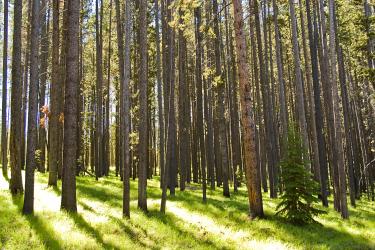Safe Burning 101
You’ve decided that prescribed burn is right for your woods, and you want to give it a shot. Where do you start?
As with so many other things in life, planning is the first and most important step. You’ll need to consider your site, your season, your firebreaks and safety equipment, your crew and any required permits and notifications.
- Step 1: the plan. For a prescribed burn, you’ll need to develop a burn plan. That’s just an outline of where you’re going to burn, what you want to accomplish with your burn, how you’re going to do it and how you’ll evaluate the results afterwards. Your forester can help you with your plan and some states even have templates that you can use. It’s also helpful to include the cost, time of year, who’s going to help, and what you plan to do for safety and liability concerns.
- Step 2: the site. Know your property boundaries and the locations of major features, such as buildings, fences and gates, power poles and lines, wetlands or streams, trails, and roads. Walk your land and note anything that can speed or slow the path of fire, like slopes, valleys and open areas. Make sure to identify areas with lots of fuel, including matted grasses or dead trees, and any places you don’t want burned. You will also want to note any smoke sensitive areas such as hog farms, homes, and airports on your land or on any nearby properties.
- Step 3: the season. Next, you’ll have to decide when to burn. You want low wind, moderate humidity, and temperatures between 40 and 60 degrees Fahrenheit, however temperature depends on location and burn objectives.
Many experts recommend burning in spring, just before everything gets green. At that time of year, the fire can consume dead plants before desirable vegetation has grown in, and the nutrient-enriched soil will feed your woods for the rest of the spring and summer. Late-spring and summer burns work well but are harder to control. Fall burns may or may not be effective, depending on the availability of fallen leaves and other fuel for the fire. Your forester can help you decide what time of year would be best to burn in order to meet your objectives.
- Step 4: the firebreaks. Your land may already have some firebreaks, in the form of ponds, plowed fields or roads—anything that will stop a fire. But you may need to create a few more. You can do that by mowing, plowing, bulldozing, disking or (on the same day as your burn) wetting a wide area around the area you want to burn.
- Step 5: the equipment. You should have a sprayer capable of 125 pounds-per-square-inch pressure and at least an output of 6 gallons of water per minute. Lower-pressure cattle or field crop sprayers with handgun nozzles can work if you have a small burn area with very safe boundaries. Ration your water to make sure you don’t run out partway.
You’ll need a drip torch—that’s a fuel-filled canister with an igniter that sets and directs the fire—for the actual burning, fire tools, citizen’s band radios or cell phones to communicate with your crew, first aid kits and plenty of drinking water. And your clothes are important too: wear nomex or natural materials, like cotton or wool, and leather boots and gloves, because synthetic materials can melt onto your skin and cause burns if they catch fire. It also pays to wear eye goggles, face masks, and hard hats.
- Step 6: the crew. How many people should help with your burn? It depends on the size and complexity of your fire, but most burns require at least three or four people: one to set the fires, one or two to watch and control them, and one to “mop up” or extinguish the fire. Ideally, at least one member of your crew will have experience and training in the use of prescribed fire—and the more experienced people you have on hand, the better.
- Step 7: the paperwork. In most places, you will need a state or local burning permit before conducting a burn. You may even need to be certified. Plan to complete these requirements well in advance of your burn date. And even if you don’t need a permit, you will need to notify your neighbors and local forestry, fire and law enforcement officials. You don’t want to raise concern, and you do want to have help available in case there’s an emergency.
Now that you’ve laid the groundwork for a successful prescribed burn, you’re ready for burn day.
Learn More
- Developing a Prescribed Fire Burn Plan
- Considerations for Prescribed Burning: Tools and Safety Gear
- Considerations for Prescribed Burning: Timing a Prescribed Burn
- Smoke Management for Prescribed Burning: What to Consider
- Considerations for Prescribed Burning: Ignition Techniques
And check out these excellent videos:
From ISU Forestry Extension's How To Perform a Prescribed Burn Series and their Considerations for Prescribed Burning: Tools and Safety Gear publication
- Planning your Burn
- Elements of a Burn Plan Part 1
- Elements of a Burn Plan Part 2
- Personal Safety Gear
- Tools and Equipment Part 1: Drip torches, hand tools (round pointed shovel, rake), backpack air blower
- Tools and Equipment Part 2: Flapper, backpack pump or backpack sprayer, reserve tank
- When to Burn
- Smoke Management
- Ignition Techniques
From NC State's EFire on Personal Protective Equipment
How can I get more tips?
It’s simple! Enter your email below.

